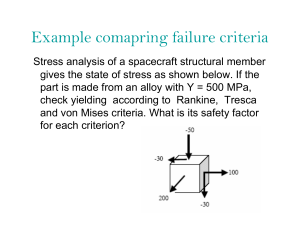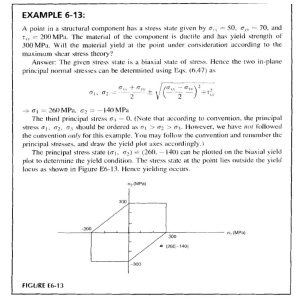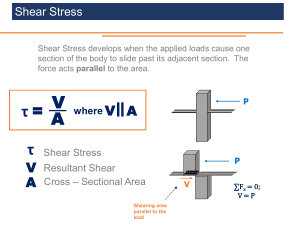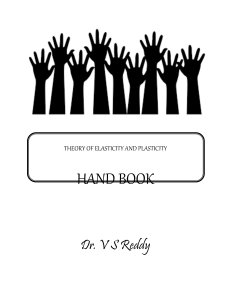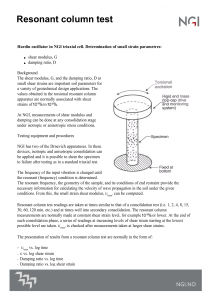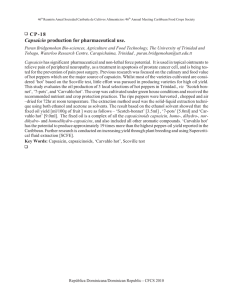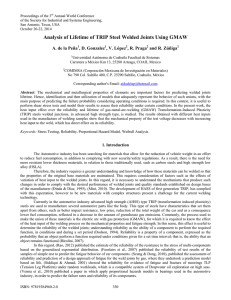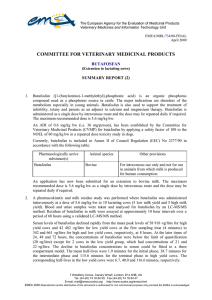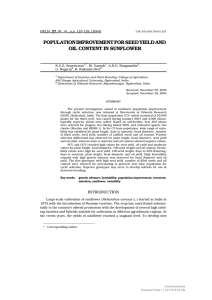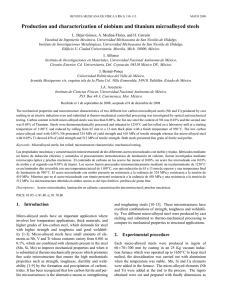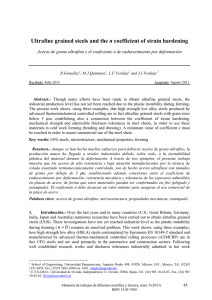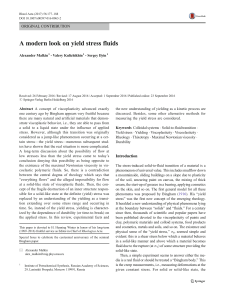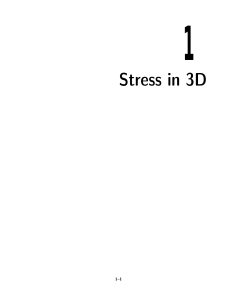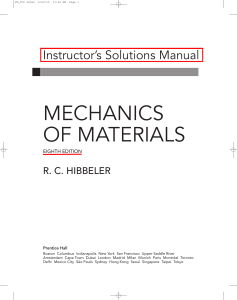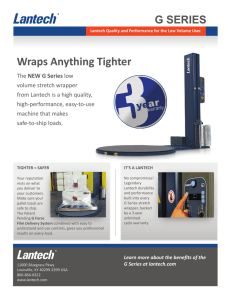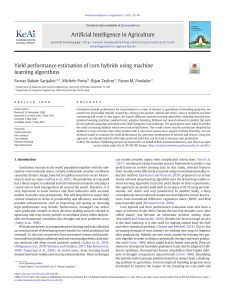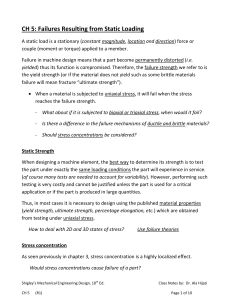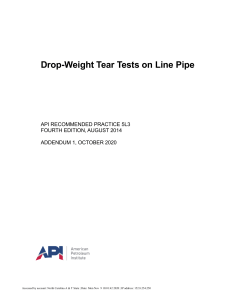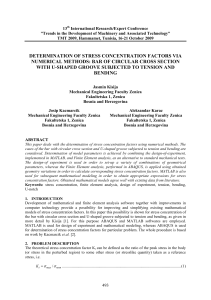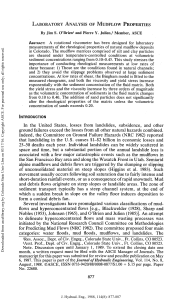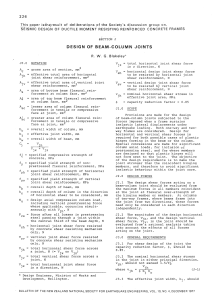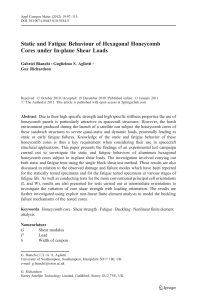Shearing properties and poisson`s ratio of structural and alloy steels
Anuncio
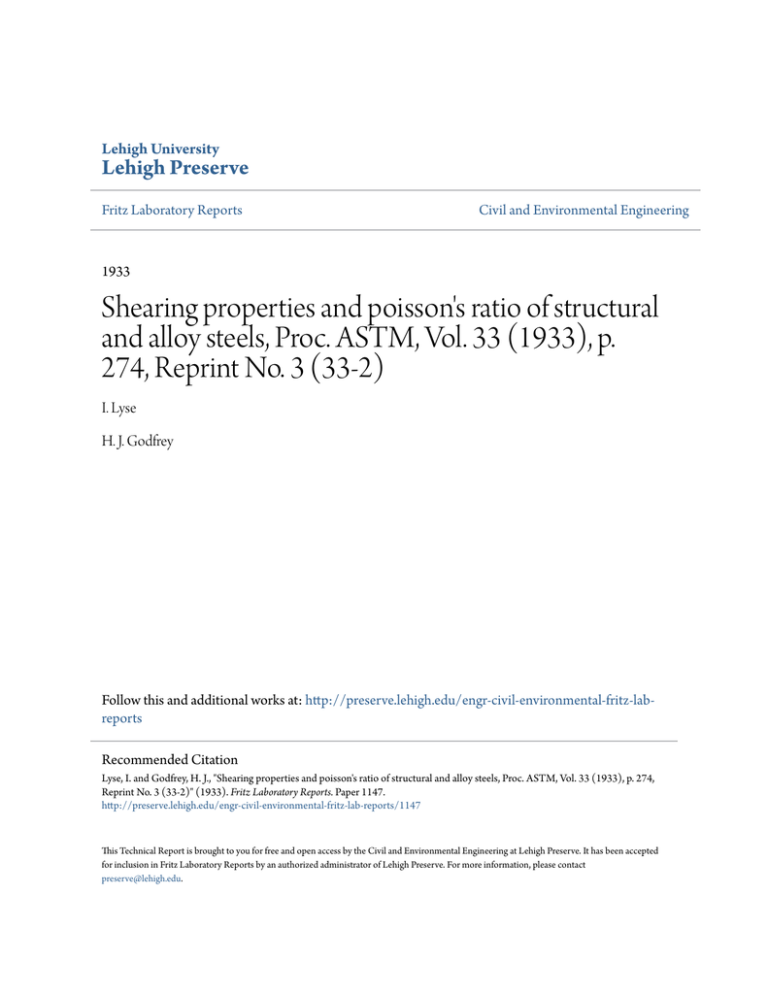
Lehigh University Lehigh Preserve Fritz Laboratory Reports Civil and Environmental Engineering 1933 Shearing properties and poisson's ratio of structural and alloy steels, Proc. ASTM, Vol. 33 (1933), p. 274, Reprint No. 3 (33-2) I. Lyse H. J. Godfrey Follow this and additional works at: http://preserve.lehigh.edu/engr-civil-environmental-fritz-labreports Recommended Citation Lyse, I. and Godfrey, H. J., "Shearing properties and poisson's ratio of structural and alloy steels, Proc. ASTM, Vol. 33 (1933), p. 274, Reprint No. 3 (33-2)" (1933). Fritz Laboratory Reports. Paper 1147. http://preserve.lehigh.edu/engr-civil-environmental-fritz-lab-reports/1147 This Technical Report is brought to you for free and open access by the Civil and Environmental Engineering at Lehigh Preserve. It has been accepted for inclusion in Fritz Laboratory Reports by an authorized administrator of Lehigh Preserve. For more information, please contact [email protected]. f c/ ./ . .' . , / '/ I ../ . SREARING PROPERTIES AND- POL'3S0U.S RATIO .. - By _Inge- ~sel, ' . or STRUCTURAL ' . AND M:UJi STEELs .. . and H. J. Godfrey2 Synopsis The paper describes the results -of tests of' different gradesofstI"Ua.. turaland yield t1110y pG~t propert1es. steels b de:termine shearing pro.parties (tllOdulU$of elasticity" - alld ult..!.!t1e1.teatre:!;gtb) and the1r relatioll to -t4e GorrespOAd!ng tensile POi13L'i..'!t11 s ratio was aJ.:$oc determined. Sbear1ng properties were det.er.... mined from sJ.,ottedi plat,s. specimens tested $n tenaiOl1 endfr'011l solld and hollow Ttle resttltsshowcd cOllrJ..df':l'able variation in t..hm ·rat1o _of yield point in shear to yield point it1: tension for the dii'.eerent. ste~;;l(S. -ShearilJ-g modulue ot el.astic!. ty determihfild 'by t'dTeat mOOBUt'€;I\loot ~gJ:"eed ree:~:onali11 vm11 ~i thvUUEls ealculated from values of toosiPla ntedulus and Pcdss@'~a rati~.. out at the Fritz Et'l.gineeringLaboratory" I.eh1gh lfn1ve1"~ty, it was ratio between-the yield points in shear and in tension varied different grades of' atrueturalsteel. fo~dthat cons:i.~erably the for In order to study the shearing properties more fully, the 1la,v-est1gatlon reported in this of. 'nw- vraJ.ues of pa~er W$S .carried ou.t, in which yield point,; ultimate strength and modulus of elastieity in shear and tension were determined and compared for an'Wnber ofdi.fferent grades ofst:ru.ctural steel and ten. heat-treated alloy steels.. Poisson's ratio tor these steels was also deter- lResearch Ass$.stant Professor of Fag1neering Materials. Lehigh University, Bethleheim"Pa~ 2Research Fellow in Civil 1!ngineering, Lehigh University,_ Bethlehem, Fa. m.irJ.ed by directmaasurementof l.eterd d~fQrllmt1onQf spec1m.el'l$ under tension•. Since the ab.earlngproper'ties o£$teel are more diffleu1t to determine than ltstenailepropert1es.J several different methodsQl test were used as de-·scribed hereafter :.in: determining yield point end u1timate~ strength ~il shear. Shear.... ing modulus o£elastic1ty(i) was determined by theuaual toralon test, end by computation from the ten$ion modu1\l.8 ofelestiCity :(j) and P.Qi$Soni~s rat.io 54·using the f01loW1ngequatlQ.rit: ., . Ma.terials The .several grades ofst!'tlctural ateel cG1Ji.prised roUe¢: .1....' 06.8,. sof''t ,steelpltttesi.tank $teel plates, and l~:lJh :rcolleo.rod.. There 'li101'ealsQ inc1:uded: OOIlle eo:t"~.t:medi'UU1and hard $teel rods. ()fn8trl,U~tura.l:n!·grade and astructt11'ElJ.. nt(\..kel' stee1.;,- The ton :9.l1QY' ateels inclr1.clad m&lgan:Eme~v nickel, chromiu.r.e, molybdenum, vanadium and t\1!lg~tensteels. li;ine were tested· in the i'orm 'If:, ~11\1~. '~am.eter condi tton8,~ 'The· tenth was teS'~ 1n dioWlet,..- ~peci""e..,S Chemi~col1toositlons~lldhoo;t treatments a1'S ,given Spec1man$1natmea.ledandquenched~~,.m 0)\ 18",i1. '" the It:as-rolledtt conditiotl. in ,:' -. ' Table,n~ (Size?) The Bethlehem Steel Co., Bethlehem, Pa... , suPpUedall· materials tor this invest1gatJ:<m, vdth theexeeption of one of the. alloyeteels' '\wch was tur.... niahed by'rne'Lukens Stasi 00., Coatesville", Pa. Specimens, Methods and Apparatus S~eimens from the I-beams were taken .in all eases from the ¥'lebs., Sinca ..•. these were inmost.' eases only'about . . . . . , ' . :i in. thiclt and the plateso~:" about . i in... thick" the tlsualcylind1i:cal tQrsion specimen' Cou14 not be used for determi~ng shearing propBrtief;l and slotted plataspee1mElD.s described wlow, Were l1sed~", For P\lltes ~-\ ~ S-~ we"t. 518" H'ic.l< ~V\cl ~otl, ~\ .. ttcd p\ote\ Il",d So\i~"Ta" sioV\ Speei"""l'\$ ""tY<. WIlde f\"o""" ihese plates. t.he remahling structural. me.ter!~l and for all t,ne alloy steels", shearing properties were determIled on' ~1l.:i.ndrie~ torsion ,spe:ei.mens., For ;reasons of econ01l11. solid spec1menswere ~j tt~l,~\.1::d6;~i:"~1"~ec~~:M:xpensivetha.n the hollow f.Wlln.. .\~ drlca1spe.($nen~l however, -.3 .~",were u$$din te..s.ting three gl'lldes efsteeJ, ~.ll. " , 1M , ,. , 1 , ,,"c!~4'" These tub'\Jlar' specinlens ,,"Jere ~ ~.Aou.t'Sided;tame'ter witt) a1n~ wall tMekne.ss. h.t>J t.t_~. ,~ Va/ue.s 9/~" ,'11 itt!dd,eI 746/(._ So/,-rI Ollrlf!O//4 W 70,:/0'" UJ';s. them, NQi;,e......,....1l.b!ehones? There- 1:5 Bothing to ide.'ltify ~l:d !lovalues are given that can be identified f~oo th~ data. ' " " T,~nsi.Qn mid sl1earing t.-ests 'We're' a2ao made' on i'- aud l.;.m... dlamew:lt bars machtned £romS. .roU'ad li...iu~, baro+,structural at/eel" t9 dei{erroi!.l,e any effect of used by Seely andPutnamti).. The illat~~tt 1i"hi¢fl.-i~Ulu$trated 'in Fig,., 1, eon~ siats ~r t;'>'K)' relati'V0 'steel eol1tU~ rot..~tion m~y inst1'1i1tl@t ¥ia,8 attac.hedto, the speaim.9l1and soco:ns't,rucwd that ·the:ir be 'meas\U'ed by anA,ut(1s dial graduated to: calibratedagaine:t. opservatj,ona by The. slotted wide , ~ , O.~lU.. The' tnil·l~O.rS..and te1esCop(la •. ' platespeClmen" first used byr;t~~and. Wilson .{5},. is 41n.. i~c i~~",t~.J t:9 U ' I te. ;\'Gf of MIl,teti81. .. " .. '.: . . . ' ""-1 'by 9 In.'' lonll~ In.. t~ick" and i$ prepared by cut:ting·twoparalle1, slota, at, ~ m-in·.. i" ap.~e of 45 (leg,. to the long! tudinal &.aus, ~tendingfromp'ointe on that Uist1n'~,apart tooppos1teedges of the' spae$m~. \'¥hen :aucn 'aspecitaenis p1a(\edunder teusion_ as shown in. Fj"g. 2 (to be supplied) ,1'h~ .she"'i .. ~ 0\1"'-t"t '/a. ,~. sectl"lJ ..... (Su, ~t+c1d1C' ~'rt. ti'sh,b.. \ed .f'~il":3 ,"IIe",,:\, p\..tl\~-l(.\asil'c. prc;,.\",'r<' !lot c... ~iVl'\ .. hr SlbH("Jp\arc. SpeciWlt''''',)>>\)~,t"bl/'''H tttl.rOM"tt')oJ wf\o't vltd f,,, de+t""i~h" -1~~ Jield pOl"w,t "u~ cl 1~e "",.d"I,,! of""~~ Silliif'd p.lG~e4 Sped\lhUts. -rRct I1lt,'Mtlfc. SfWMOH o~ ;he sloi'feJ rJ'fc. 3r(lciWlC'''''~ wlI,i 1.o S1\,use£ obtal~ed . ,.f ...... ! N9te~Insert bare. a descriptiOl1of. nature.. ofstress sectlol't, howdet-ormat1on is' measured by Huggenberger \ t.~som..eter.,cmd. ViM. t gage 1.·.ent:th1S used..... Th1 ..'". s laplace to.', I bring out that tensometer \iI1l.S used Qll.1y to measure deformation £0.1: yield point,.. and nat f.·or modulus.. Apparentlyalotted 11n t 1».. ';; I ""specimen was used for ultimata ahearingBtrength.. Tensile·dei.ormation wasmea'sured by a Ewing ~ensometer. . . ' PoisaonJ;sra.tio. lateral deformation was measured by meaneof Indetermining nug~~nberger,N(ten.-. Bamsters attached to aspeeially constructed circular collar-of' spt-:1ng steel. shown in Fig. ~;; the c~r . As was attached to the specimen. by two· .scrEnVS plaeeddi... metrietU.1Ye, The pressure exmedby the screws was sufficient to a~ow the lateral :' deformation to take place ldthout loosening the collar. The multipJJ,eatlon ratio Githa collar as determined by d1rect ealibrationW&s 2.16. Th1ssimplerigproV'ed very successful in the 'measurement of lateral deformations both below and above the (1.0 00 00$ yield point. Le.teraletrtdns were measured directly with. this apparatus to 'jio m!i io.- 'Many. of the st.ress...strain diagrams, both lJK ? ti¢Ularlyf'or the alloy steels (see Fig.. yield point. 51. 1n&h~1" and·wnslol1. par.... dldnot show· a sharp break at the In such cases, the yield point was determined as the stress at which the tan~~tress....strain eurve has a slope (ratio of stress to strain) one.... ~rl\~Of the ltlitial straight-line portion.. . Beaults of Wests The results of the tests on 13tructuralsteels are given in Table 1-, and those on alloy steels in Tables :tI, nI aad :tV. 'lypiealS1:a'!'ess...stra1nc'!U"Ves are shown in Figs. 4 and 5. ..." ~. j( .',. Effe~ofSbap!'and Sise()f.'•.T~§t$PAAimm\l Comparativeetress-straincurve.s in ahsuocbtained with slotted plate specimens a.nds.ol1d 07Undl'ical specimens from the same .materiu areshoW!l in Fig. 4. It is noted that these tw() in shear. types ofapecimena,gavs "1f3r"J nea.r~ the· same yleldpoint However;, at a givEltlstress the measured str$s of the slotted plate speci- mens were "lesstban those for the solid torsion bars. The slotted' plate specimens gave a more dtilfiz;d·te yield point than did the tor~d.on bars, and btgeneral the re... sults were maTe 'consistent.. she~1ng Th$ ultimate on a plata specimen than when determined on a strength '001"8100 Wli13 less when determined bar" and the traeture of the former indiQated a pure shear feUure. 'lheaverc.ge yield point 1n shear determined on the hollow cylindrical specimens ~es no.t reported }lara) averaged abou:~90 per' cellt of that determined on solid bars. C~C.\b~(~ "'\alo\~ ')iYf!-V4\o.,t-l P..... b\)\~ ~Q\ICl"'-l -.d h\"'\ to''f$IQ~ tesh. O~I'o 'O1~\4' ~O\'o'I~ \1I\4U,·trMO\e. 'l.'hus ~hYlNllY\tA 011\ hollow Sf(~\'\IIo\el1 s. UtI\vu";" 11'b4, (c-... c.l~~l!'~) O~( AlIlvl,' of- -:l. 0"" ~oy~ .SI~'i'1'l(!""\. . . . .~lote",-A:re any data at all given ~or 0011.01'1 eylindricalspecimen.s? Was i deteminedi.'or any hollow specimens? There 1a so Uttle given for hollo1i1$pecimens that one questions ineturling thea at ell. Tbe tests to determine effect of size of BPec1men show that. the smaller specimens (i and l1n. in diameter) machined from 1t-.1n.• bars gave J.cnverstrengths in bothtenaton andsbear t~ did the It--1n. spec1~~, d~e probably to the effects /l1l.L. of rolling dlJrlng mat1ufac(mre. ~oru~"'$ ~t(Cl The moduli of elastid. ty, however, were VfSrY nearly .~ . the same for the several sizes of spec1ntena.(5ee Table I.) frgnert!es .of·StrueturalStee1sl R&ferring to Tabla It. the shearing yield point for ord.1.na1'ystructural steels varied from 1$,.500 to 29,200 lb. per sq. in.,; they-ield point-in tension va., ned from 26j19OO tt;) 51;,500 1b<l:' per sq. .bi'!'.' for the Game materlSls~:" Steals con~ taining nickel gavashearing yield. point as lligh 'as' 41.,700 lb. per sq. 1u~. Tll.ers.tl~between tbeyield points in shear and in tension~ given . in the laat«>lumn of tll~ble,Vary greatly_ For ~led .1~11i$·the ratio ?a,. .J:O.5~;.for roll.ed to . . "'" sort steolpl&·t~s. .from O~527 am:t 0.671; and for rolled It-in..~a'the average riedfrom 0.,505: to O.654V\tatUt steel pI.stes, .from 0.509 . . .' ratio WllS :()...629. . It should be noted that anumbaroi' the. stl'Uetura1..grade$~ bad shearug~lel:.d:poi.nta~hen determined on slott~late.~pec1mens, eons1der'ablq lass than 60 ·pe;-cont oftha yiel.dpoiut. in tension,., If .thestress developed bye hQ.u.owt'l)rs~specimen • is considered· tobeeor:ract, these ratios would ~glYJ:.ower .., . .(, I \-... ~u\ll ~ ai VI t I I II. \ t>V\ '~ 0 0. QJ • ", II) (:l ""'Y .) t-.t, l l '1.· c,.~"\\~~ = ~ becorre~ 01 .... ~~ G Q . ~/) b4 'The:. addition ,jrD.1ekal· raised the ratio of' yield .pOin'ts in shear end . ~..-af\ . .. . . . . : ' . tension to asmuehas ,0.889. PoissotiJe ratio for thedlfferent types of structtJral. ,steel varied only between 0.271 and O.~02.. For desig,o; purpose.til, the be just-iried.. . Us& of a value ofO.5seemft to ~ .'n.1esbearing moduluso! ,elasticity abOwA'~ high' degre~.or 'Wliformity when calculated from the obs-eJ:\ted longitUdit)~and 1.a.te-ral.strairW.. However., the modulus ob~ed l::W dtract measurem:enta on the torsionspe~showed consid-or. able variation.. ':1p1cEdatres~train diagrams f-or longitudinal, lateral and torsional' deformations of structural .steel are showni.n Fig. 5.. It1,s noted that the lateral defG'rmationj,ndteated ashal"p yiold .poilltat the same stress· as did the longitudinal Pwtmrtie:e ·gf. AUgr,sWglat, . T~ hardness and dttctiUty of theaUoy steels are given in Table In,. together with a descri.ption or the t0i1S1on test fracture. Att-ention is oalled to .... ~ 'l'ab~e IV. The yield pQb't 1n tension varied from 51.SOO to· 53_000 lb. per s~-. in. for the steels in the annealed condition. and f1'oa55,000. to 124,000 lb•. per sq,., in. for those 1n tbe quenched condition. OD soUd torsion~c1mens varledtrom The ,y1eldpoint in shear as determined. 3.5,50(} to 45~750 lb. per -it..in. for ~, .8.nneued condition and ·from 44):1:00 to9S...tlOO· lb. per sq. U,., £ol',.fquenched: con.... d1ti01l. In general. the ratios between the yield points in . shear aD.d in tension .. were greater for theannEtaled than for the quenched Sl'iecimens-, ranf':1ng from 0.174 to 0.894 tor the former $nd from 0.662 to 0..809 for the latter. The J...... alloys~,. . bothlnaransaled and Q,l1enehed condi.tiona, ehoWl\cana1derablygrea:tler rat10s betwe• . ' yield points inahear 811<1 tension than the structux;al steels-o A nUl',D.bet" of the exc~s in shear in ~ealedsolld torsion speci:mel1s' gave ultimata strengths of theeorrespondiug tensUe strengths. T1ns' is due to tl16US.$ of 1'.00 ordinary torsion fo1:lm11a to deterndue ultimate strength.. l1otrtdthS.tanding tl'la~ the foX'lllU1a does not hold a.f'terthe stress has exceeded the proport4.onal limit of the material. Poisson's ratio varied £1'0$ 0.272 to 0.320 £'or these ten alloysteellh With the exeept1~ of the tun,gsteu -stee1(Bo. 7) there was little differenee between Poisson's ratio tor the· steel in the .QUnGued and quenched conditions.. stt"es/il....stra!n Typical/diagrams. tor longitUdint.tl t lateral and torsional deforraations at one of the alloy stee~s are shown in Fig. 5. Atten11onls' called to the gradud transition from a straight line to a .'~ in i l l three eases. After the propor... tiona! 11mlt was reached -tiltl rel.ati:v-e rate of lateral deformation inoreased over that of the l~tud.inaldeformationso thatPoJ.SSOll:'s ratio 8.pproaehedO.5. vestigatioat. 1. The. apparatus developed formeasur1ng latem and torslo~stratna " . against other instruments.. 2.. S~ottedtplate ·a~s and solid torsion ;specimans g~ve ~ppr<»d.ma,tely the same Yield point. in shear.• 5",. Steel ofstruetural· .grade. sOQweda wide vantltlon in the' ra~ . .,.:"'t yield point lo~ '0.•60 inshe!:U"~to y:1eld point or . 1n tension.. In gErneral .th& nt1() waG· be..... . for spec1mensfroT4 rolled plat.es and structural ".e.tlOns. e.p.oissotl's rati.o f~rr structural steel. vartedfrQl1l o..m to 0":502. 1. For ~ steels the rat10 .of yield paints. insheal" and 1n ten... slon varied "(wjtvteen 0.774 ·and 0.894 fol' annealed condltiOJilwd betfifin; 0.662 and o.aoo tor Clllsnob.ed-and-..drawncondition. 8,. .~ Poi{Jlson.'s ratio. for alloy steels varled betw~ Q:.2"n end 0.'520.· · - A4 I I A~ Frct)+ View -....0) ' I------iE---"-I'---- ... (~!rl- :~ ....... ~~\l
